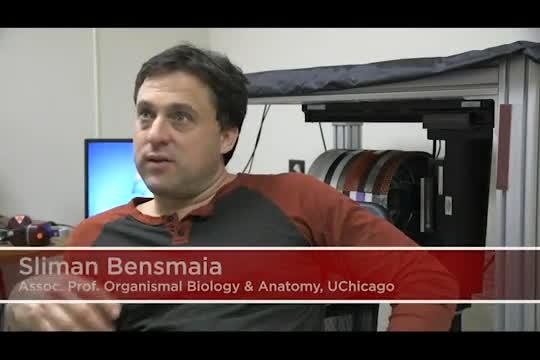Scientist working to make the prosthesis feel: Who is Sliman Bensmaia?
Scientist Sliman Bensmaia, who made important studies to give a sense of touch to amputee and quadriplegic patients, died at the age of 49. So who is Sliman Bensmaia?

Sliman Bensmaia, whose pioneering work on the neuroscience of touch opened the doors for amputees and quadriplegic patients, allowing them to not only hold a mug of coffee, but to feel the warmth, for example, and know how much pressure to apply to hold it tightly, died on August 11, 2023, at his home in Chicago. Bensmaia was 49 years old.
The news of Bensmaia's death was borne out by the University of Chicago, where he was a professor in the organismal biology and anatomy departments. No explanation was given as to the cause of Bensmaia's death.
Bensmaia was a postdoctoral researcher at Johns Hopkins University in the 2000s, when the US Department of Defense committed $100 million to prosthetic research, facing large numbers of wounded veterans returning from Afghanistan and Iraq.
Entered uncharted territory
Scientists were making tremendous strides in the field of brain-controlled prosthetics, but giving the sense of touch to users of these apparatuses was largely unexplored territory. Patients could not sense whether the material was rough or smooth, whether it was in motion or stationary even when their limbs were in space.
Bensmaia took the next step, understanding how the brain receives and processes information through touch. This, in turn, would have allowed the prosthesis to function close to an organic limb.
In an interview with Discover magazine in 2016, Bensmaia said, "Touch is a very rich, very multidimensional thing. "There is a lot we understand, but there is still a lot we don't know," he said.
It started by trying on monkeys
Bensmaia's fundamental research involved rhesus monkeys, many of whose nervous systems are very similar to those of humans. He and his team attached electrodes to regions in the monkeys' brains, poked the dots on their hands, and then analyzed where the brains got this sensory information from and how the animals responded. They then used electrodes to simulate these pokes to mimic the experience.
Speaking to Wireless Design and Development magazine in 2014, Bensmaia said, "When you think about wiggling your arm, that part of your brain is still active, but nothing happens because of the disconnected connection. "The idea behind this project was to directly stimulate the brain to attach electrodes to the brain and produce some sense of touch to better control the modular limbs," he said.
Most scientists focus on either pure or applied research in their laboratories. Bensmaia's team—more than 10 undergraduates, graduate students, postdoctoral researchers, and technicians—was able to do both. In addition to neuroscientists, he employed teams of engineers and computer programmers.
“He ran his lab like a small company,” David Freedman, a Chicago neurobiologist, said in a phone interview. Such coordination was necessary for Bensmaia's complex work. The sense of touch contains many precisely measured inputs such as pressure, temperature, movement, and stiffness, all transmitted to the brain through approximately 100 billion neurons and 100 trillion synaptic connections.
"The hand is, in a way, an expression of our intelligence, our neural sophistication," Bensmaia said in a 2022 podcast with Mark Mattson, a professor of neuroscience at Johns Hopkins University.
He was a talented pianist
Bensmaia, a gifted pianist who plays regularly in Chicago, compared the flow of the inputs to a "nervous symphony."
He shifted his research from Johns Hopkins to the University of Chicago in 2009 but continued to collaborate with research teams at the University of Pittsburgh alongside his former colleagues at Hopkins.
In 2016, his team and a group from the University of Pittsburgh fitted 28-year-old Nathan Copeland, who is paralyzed from the neck down, with a prosthetic arm that allows him to feel with his fingertips.
Visiting the lab, President Barack Obama watched Copeland at work and then punched him in celebration. "This is incredible," said Obama.
Sliman Julien Bensmaia was born on September 17, 1973, in Nice, France. His parents, Reda Bensmaia and Joëlle Proust, are philosophers. Sliman grew up in France and Algeria, then moved to the USA at age 15.
He was working on the bionic breast
He studied cognitive science at the University of Virginia, planning to become interested in music. However, his parents convinced him to pursue a PhD, and after graduating in 1995 he enrolled in the cognitive psychology department of the University of North Carolina at Chapel Hill. He received his doctorate in 2003.
Bensmaia was a prolific researcher; Together with his colleague Stacy Lindau, they began work on a bionic breast that would restore sense to patients after mastectomy.
Bensmaia left behind his parents, as well as his wife Kerry Ledoux, his brother Djamel, and their children Cecily and Maceo.
He always had an interest in music.
Bensmaia never lost interest in music. He formed a band called FuzZz with his Chicago colleague Freedman and even released an album in 2013.
But it's only been in the past few weeks that the two have started talking about conducting a research project together on the relationship between how the brain processes visual and tactile input.
